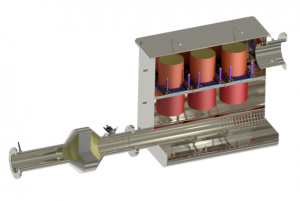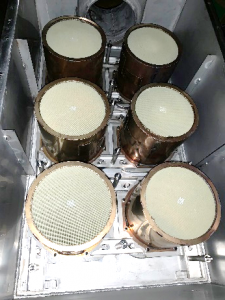
The European Commission are to introduce the world’s toughest emission standards for non-road mobile machinery (NRMM) for Construction Machinery/Power Generation Equipment, Rail-Road Engines and Inland Waterway Vessels.
The Stage V standards adopted by the EU Parliament in July 2016 which is now coming into force will tighten restrictions on non-road engines and equipment and set stricter limits on emissions of particulate matter (PM) and NOx (NO/NO2).
The implementation of Stage V effectively mandates the use of a “Wall-Flow DPF” in the aftertreatment system to reduce both “Particulate Mass” and “Particulate Number (PN)” for diesel engines between 19KW and 560KW as it is almost impossible to achieve Stage V emissions without the wall-flow filter.
The most common aftertreatment arrangement for Stage V is likely to be a DOC upstream of a DPF followed by an SCR and ammonia slip catalyst (ASC).
Some of the concerns in the adoption of Stage V are:
- The Space Envelope available in which to install the after-treatment
- The strategy for DPF regeneration.
Proposed Stage V equivalent Retrofit Solution from IMS
IMSeco has developed a combined DPF+ SCR/ASC Reactor with an upstream DOC that can be retrofitted to existing Stage IIIA engines to reduce all legislated emissions in-line with Stage V equivalent levels.
The system utilises Hydrocarbon Injection in front of the DOC to “Actively” elevate the exhaust gas temperatures in order to continously regenerate the soot captured within the Wall-Flow DPFs to elimate any concern over potential filter blockages at low loads/low exhaust gas temperatures.


The system comes with “Airless AdBlue Injection” and an AdBlue Mixer Pipe embedded within the reactor to reduce the space envelope required. The DPF’S are located within a “Lower Chamber” while the SCR+ASC substrates are within the “Upper Chamber” which is completed sealed from each other preventing any potential by-pass. A quick-release mechanism allows both the DPF and SCR/ASC to be removed together for servicing/maintenance (removal of ash from the DPF).
Having the two separate chambers allows for the Inlet/Outlet pipes to be positioned on either end of the reactor (entry/exit can be on the same side or opposite ends as shown in following photos)
Example of the IMSeco SCRT Reactor.


Why Retrofit
With the introduction of the London Ultra-Low Emission Zone and the NRMM LEZ in London, emissions of both PM and NOx are being highlighted as a growing concern.
From January 2020, GLA will require Stage V emissions from power generation equipment when used on construction sites within Central London or Canary Wharf.
HS2 are also adopting a Stage V requirement for NRMM on all of their construction sites.
Outside of London, there are potentially up to 30 other cities across the UK looking to introduce “Clean Air Zones” that will initially focus on the reduction of PM/NOx for “On-Road” vehicles such as buses, coaches and trucks, but it is anticipated that over the next few years more and more councils will be looking to require emissions abatement technology to be fitted to the Non-Road Machinery operating on construction sites in their cities due to the number of exceedances that are being registered in the designated “Air Quality Management Area” particularly for NOx.
Taking all of the above factors into consideration and the fact that the availability of Stage V Generating Sets is going to be limited in the short-term, the option of being able to retrofit an existing Stage IIIA engine to meet Stage V will be invaluable especially to “Generator Hire Companies” trying to manage the logistics of supplying compliant equipment across multiple sites.
IMSeco are hoping to have completed testing of their Stage V retrofit SCRT Systems over the coming months and have gained accreditation for Stage V equivalence before the end of the year in preparation for Stage V introduction in January 2020.
For more information mail sales@silencers.co.uk
